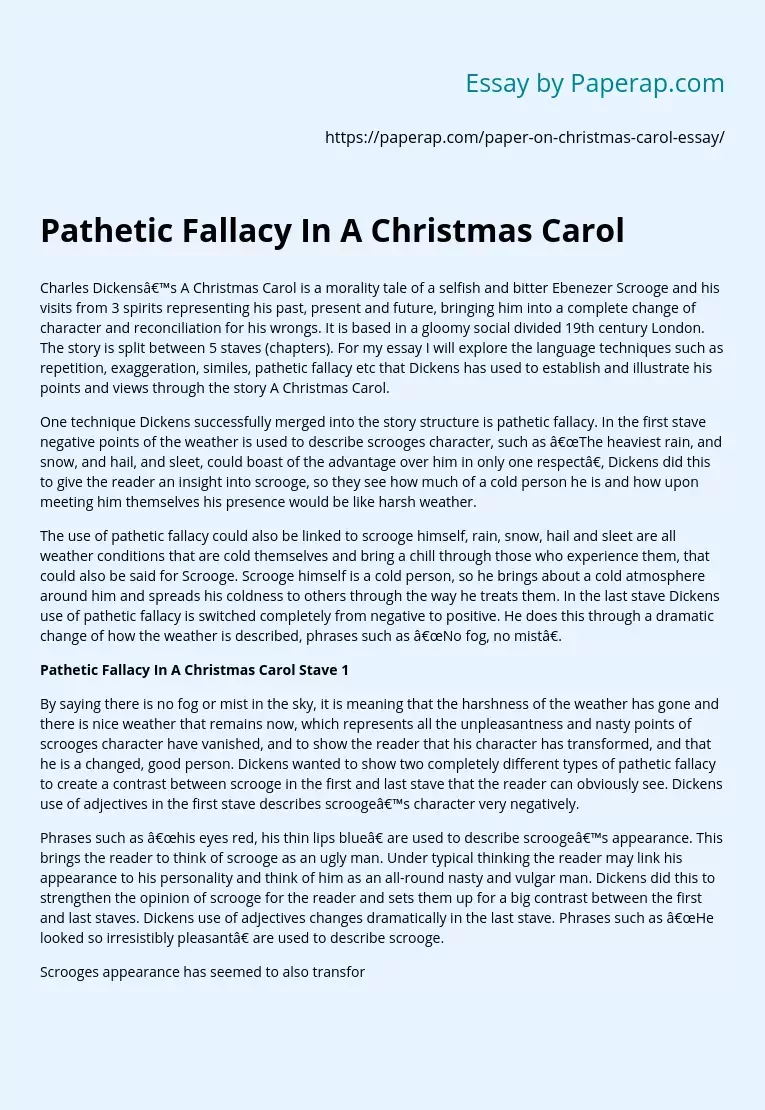Pathetic Fallacy In A Christmas Carol
Charles Dickens’s A Christmas Carol is a morality tale of a selfish and bitter Ebenezer Scrooge and his visits from 3 spirits representing his past, present and future, bringing him into a complete change of character and reconciliation for his wrongs. It is based in a gloomy social divided 19th century London. The story is split between 5 staves (chapters). For my essay I will explore the language techniques such as repetition, exaggeration, similes, pathetic fallacy etc that Dickens has used to establish and illustrate his points and views through the story A Christmas Carol.
One technique Dickens successfully merged into the story structure is pathetic fallacy. In the first stave negative points of the weather is used to describe scrooges character, such as “The heaviest rain, and snow, and hail, and sleet, could boast of the advantage over him in only one respect”, Dickens did this to give the reader an insight into scrooge, so they see how much of a cold person he is and how upon meeting him themselves his presence would be like harsh weather.
The use of pathetic fallacy could also be linked to scrooge himself, rain, snow, hail and sleet are all weather conditions that are cold themselves and bring a chill through those who experience them, that could also be said for Scrooge. Scrooge himself is a cold person, so he brings about a cold atmosphere around him and spreads his coldness to others through the way he treats them. In the last stave Dickens use of pathetic fallacy is switched completely from negative to positive.
He does this through a dramatic change of how the weather is described, phrases such as “No fog, no mist”.
Pathetic Fallacy In A Christmas Carol Stave 1
By saying there is no fog or mist in the sky, it is meaning that the harshness of the weather has gone and there is nice weather that remains now, which represents all the unpleasantness and nasty points of scrooges character have vanished, and to show the reader that his character has transformed, and that he is a changed, good person. Dickens wanted to show two completely different types of pathetic fallacy to create a contrast between scrooge in the first and last stave that the reader can obviously see. Dickens use of adjectives in the first stave describes scrooge’s character very negatively.
Phrases such as “his eyes red, his thin lips blue” are used to describe scrooge’s appearance. This brings the reader to think of scrooge as an ugly man. Under typical thinking the reader may link his appearance to his personality and think of him as an all-round nasty and vulgar man. Dickens did this to strengthen the opinion of scrooge for the reader and sets them up for a big contrast between the first and last staves. Dickens use of adjectives changes dramatically in the last stave. Phrases such as “He looked so irresistibly pleasant” are used to describe scrooge.
Scrooges appearance has seemed to also transform somewhat to the first stave, as if along with his personality, now all the evil and nastiness has been taken out his appearance has adjusted to that as well. The reader now sees scrooge in a completely different light, now that his personality and his appearance has changed he is now seen as a completely transformed person. Dickens use of adverbs/verbs in the first stave describes scrooge’s character very negatively. Words such as “squeezing, wrenching, grasping, scraping” are used to describe scrooge, the words link to how tight he is with his money, and how money hungry he is.
The verbs themselves sound quite threatening, and so the reader would feel threatened towards such a person as he. Dickens wanted to create a negative view of scrooge for the reader and so by using verbs that describe his actions in a dramatically negative way and make him sound like a money-mongering all around bad person. In the last stave Dickens describes and makes scrooges actions sound much brighter and positive in comparison to his actions in the first stave with the use of nicer verbs/adverbs.
Verbs such as “fluttered and so glowing” were used to describe scrooge’s actions. The words themselves fluttered and glowing are positive and sound nice, Dickens used words like this to add to scrooges newly found self, and for the reader to see along with a better appearance and transformed personality; his actions are also positive and nice. The term glowing could also be linked with the warmness and the renewing of his character; instead of bringing a dark atmosphere around with him, a certain glow is around him bringing to light to others of his change within himself.
Pathetic Fallacy In A Christmas Carol. (2019, Dec 05). Retrieved from https://paperap.com/paper-on-christmas-carol-essay/

